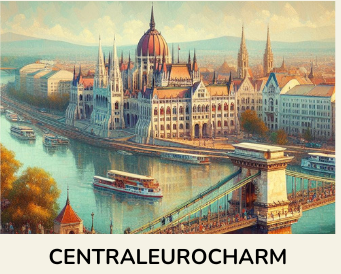Discover the Rich History of Slovakia: From Celtic Settlements and Roman Frontiers to the Birth of the Modern Slovak Republic
Ancient Beginnings
The brief history of Slovakia begins thousands of years ago, with Celtic tribes settling across the region around the 4th century BCE. These early inhabitants brought advanced metalworking, agriculture, and vibrant trade networks, leaving behind pottery, jewelry, and coins — especially near what is now Bratislava.
👉 Visit the Bratislava City Museum or Devín Castle, where ancient artifacts and Roman ruins give you a vivid sense of Slovakia’s Celtic and Roman past.
By the 1st century CE, the Roman Empire had expanded to the southern banks of the Danube River, establishing military outposts such as Gerulata. Although the Romans never fully conquered Slovakia’s rugged interior, their influence helped shape trade and settlement patterns along the southern frontier.
👉 Explore the Gerulata Roman Military Camp in Rusovce, a UNESCO World Heritage site and part of the Roman Limes.
In the 5th century, the Huns, led by Attila, swept through Central Europe, briefly impacting Slovakia, then inhabited by Germanic tribes like the Quadi. After the fall of the Roman Empire, the area saw continued migration until, by the 6th century, Slavic peoples settled the land more permanently, laying the cultural foundation for modern Slovakia.
Slavic Settlement and the Great Moravian Empire
By the 6th century, Slavic peoples had firmly established themselves in what is now Slovakia. The region became part of the Great Moravian Empire, one of the first major Slavic states in Central Europe. This empire, which thrived between the 9th and 10th centuries, played a significant role in shaping Slovakia’s early culture and identity.
The Cyrillic alphabet, developed by missionaries Saint Cyril and Saint Methodius, was introduced during this time, making an indelible mark on the Slovak language. Christianity also took root, leaving a legacy that endures in churches and customs today.
👉 Don’t miss the Nitra Castle and Zobor Hill, key sites tied to Great Moravia and early Christian influence.
Under the Hungarian Crown (11th–16th Century)
From the early 11th century, Slovakia became part of the Kingdom of Hungary, a union that lasted nearly 900 years. Under Hungarian rule, power was mainly concentrated in Budapest and Vienna, often relegating Slovakia to a secondary role. Despite this, the region remained a vital center for trade and defense.
In the 16th century, Slovakia faced significant external threats from the Ottoman Empire. The Ottoman advance into Central Europe led to the construction of fortifications and military campaigns that significantly impacted Slovakia’s landscape.
👉 Visit Trenčín Castle, a towering fortress with panoramic views, or Komárno Fortress, which showcases anti-Ottoman military architecture.
The Habsburg Era and Slovak Awakening (16th–19th Century)
With the rise of the Habsburg dynasty in the 16th century, Slovakia was drawn into a broader Central European empire. While political power centered in Vienna, the 19th century witnessed a Slovak national revival. Intellectuals and activists fought to preserve Slovak identity, language, and culture.
Figures like Ľudovít Štúr helped shape modern Slovak by promoting a literary standard for the language, sparking a grassroots cultural movement.
👉 Take a walk through Bratislava’s Old Town, where plaques and monuments commemorate the Slovak Awakening and its leaders.
The Tumultuous 20th Century: From Empire to Independence
Following the collapse of the Austro-Hungarian Empire in 1918, Slovakia joined the newly formed Czechoslovakia. However, challenges remained in asserting Slovak identity within the union.
In 1939, Slovakia declared independence under Nazi influence, becoming a puppet state during World War II. The Slovak National Uprising in 1944 marked a powerful act of resistance.
👉 Visit Banská Bystrica, the heart of the uprising, and its Museum of the Slovak National Uprising to learn about WWII-era resistance efforts.
Post-war, Slovakia was reintegrated into Communist Czechoslovakia. The Velvet Revolution of 1989 peacefully ended Communist rule, and in 1993, the Velvet Divorce resulted in the formation of the independent Slovak Republic.
Slovakia in the 21st Century: Growth and Independence
Since becoming an independent nation in 1993, Slovakia has blossomed as a modern European country. A member of the EU and NATO, it combines innovation with tradition.
Slovakia has embraced tourism while preserving its rich heritage.
👉 Wander the cobbled streets of Levoča or explore Banská Štiavnica, both UNESCO sites that reflect Slovakia’s layered history.
👉 Hike in the High Tatras, visit fairy-tale castles like Bojnice, or sample Slovak wines in the Little Carpathians — there’s something for every traveler.
Final Thoughts & Call to Action
Slovakia’s history is not only fascinating — it’s visible, walkable, and alive in the towns, castles, and countryside.
Whether you’re exploring Roman ruins, medieval fortresses, or vibrant cultural festivals, Slovakia offers an enriching journey through time.
👉 Ready to explore Slovakia’s past in person?
Start planning your Central European adventure now — and let history guide your way.
